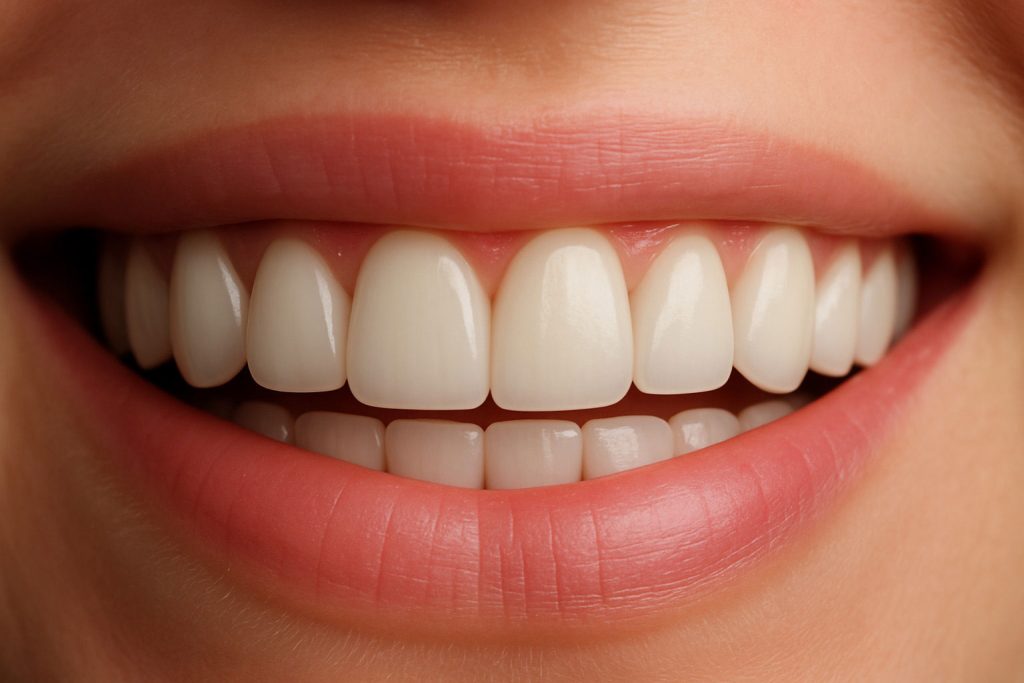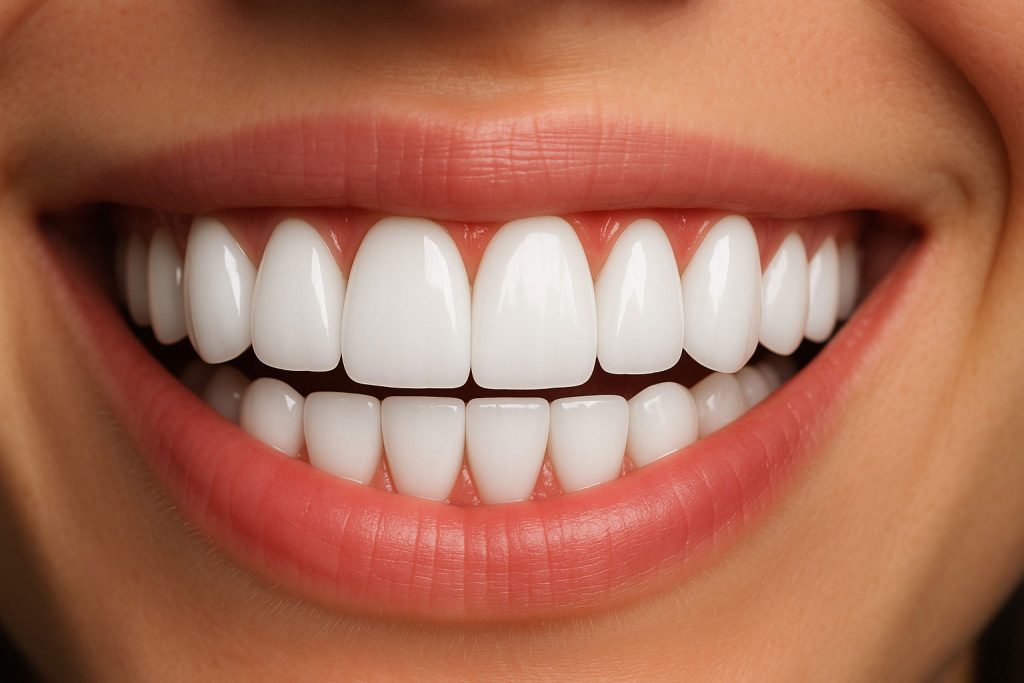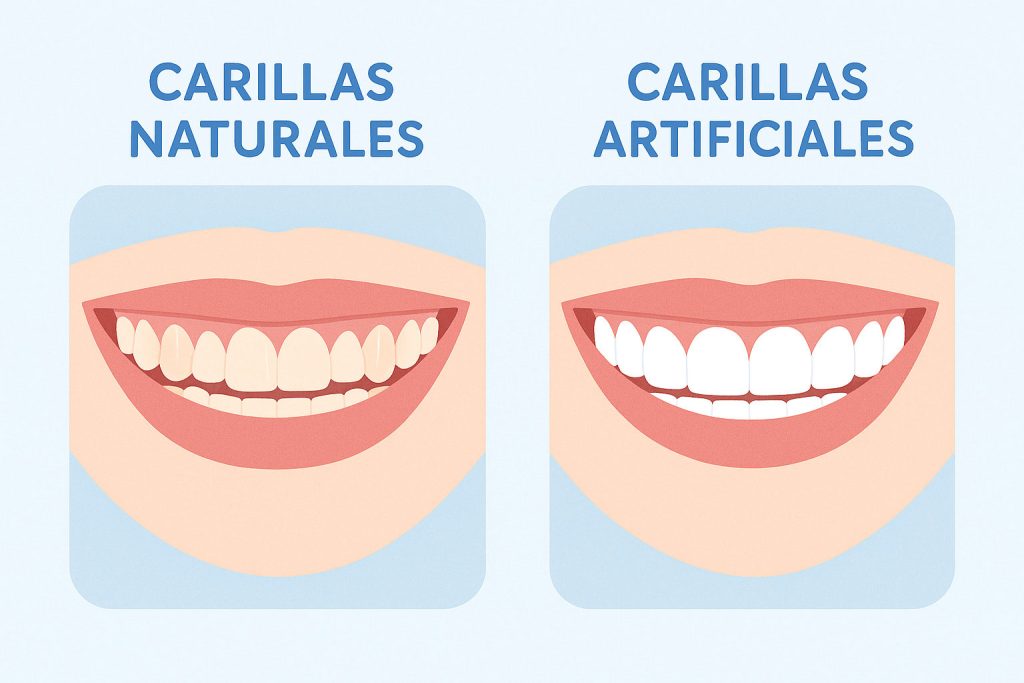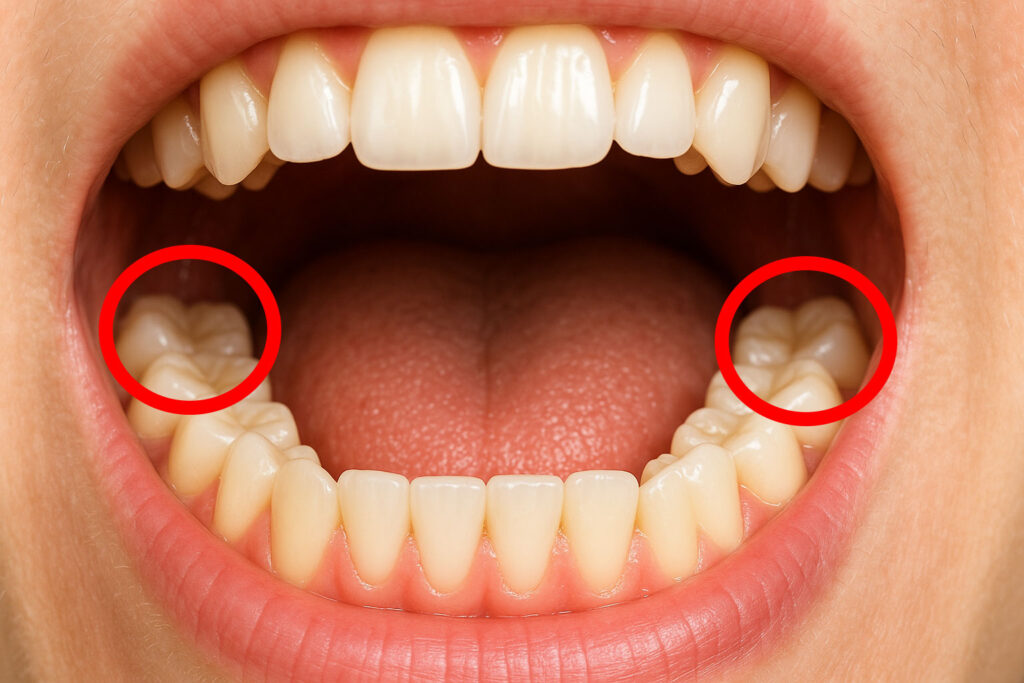What are dental veneers?
Dental veneers are thin shells that are bonded to the front of the teeth in order to improve their esthetic appearance. They are designed to mimic the natural shape, color and texture of the enamel, allowing the smile to be transformed in a very discreet and harmonious way.
They are mainly used for correction:
- Colorations that do not respond to bleaching treatments.
- Fractures or wear on the edges of the teeth.
- Spaces between teeth (diastemas).
- Slight malposition or irregularities in shape and size.
Veneers can be placed on a single tooth – for example, to repair a fracture – or on several teeth, when the objective is to achieve a more complete smile transformation.
>>> Do you live in Mallorca? Book your free first appointment <<<
What makes them so popular is that they offer fast, safe and very natural looking results, provided they are well planned and tailored to the patient.
Types of dental veneers
There are different types of dental veneers, and the choice depends on both the patient’s esthetic goals and clinical factors (condition of the teeth, bite, habits, budget). The three main groups are:
Porcelain veneers
- They are made of ceramic or lithium disilicate.
- They stand out for their high strength, color stability and ability to mimic the natural appearance of enamel.
- They usually last 10 to 15 years, provided they are well cared for.
- They require minimal grinding of the tooth in order to place them safely and esthetically.
Composite veneers
- They are made with composite resins of the same type used in esthetic fillings.
- They are applied directly on the tooth in the clinic, shaping and polishing them in the same session.
- They are more economical, but also less durable: they usually last between 5 and 7 years.
- They have the advantage of being easily repairable if they fracture or wear out.
Ultrathin veneers (Lumineers and similar)
- Manufactured in high-tech porcelain.
- Their main advantage is that they are so thin that, in many cases, they can be placed without grinding the tooth.
- They offer a very natural and conservative esthetic, although they are not always applicable in all clinical cases.
Type of veneer | Advantages | Inconveniences |
Porcelain | – Very natural aesthetics (imitating the transparency of enamel). – High resistance and durability (10-15 years). – They do not change color over time. | – Higher price. – Minimal grinding of the tooth is required. – The procedure is longer (several sessions). |
Composite | – More economical. – They are placed in a single session. – Easily repaired in case of fracture or wear. | – Less durability (5-7 years). – Easier to stain (coffee, tobacco, wine). – Lower resistance to wear. |
Ultrafine (e.g. Lumineers) | – Very conservative: in many cases they do not require milling. – Very natural esthetics. – Quick and minimally invasive placement. | – Not suitable for all cases (clinical limitations). – High price. – Lower resistance than traditional porcelain veneers. |
Materials and natural appearance
One of the biggest fears of those considering dental veneers is that the result will look unnatural. For this reason, the choice of material and esthetic planning are fundamental aspects.
Porcelain and lithium disilicate
These materials stand out for their ability to mimic the transparency and brightness of natural tooth enamel. They reflect light in a very similar way to a healthy tooth, allowing for highly esthetic results that are virtually indistinguishable from a real tooth.
Modern esthetic composites
Although less durable, today’s composites have greatly improved in quality and allow for a very natural finish. The dentist models them directly on the tooth, adjusting the shape and color in the same session.
The importance of customization
No two smiles are alike. To achieve a harmonious and natural result, factors such as skin tone, facial shape, color of neighboring teeth and even the patient’s age are taken into account. The goal is not to have “perfect identical teeth”, but a balanced, esthetic and credible smile.
Avoid artificial appearance
Veneers that are too white or too uniform can look unnatural. The success of the treatment lies in finding the right balance between esthetics and naturalness, so that the teeth look healthy and attractive without losing their authenticity.


Duration of dental veneers
The duration of dental veneers depends on the material chosen, the care given to them and the habits of each person. In general, they are very durable esthetic treatments, but it is important to know the differences:
Porcelain veneers
- They usually last between 10 and 15 years, although with good hygiene and regular check-ups they can be kept in perfect condition for even longer.
- They maintain their color and brightness throughout their useful life, as they are not stained by food or beverages.
- Their resistance makes them ideal for those looking for long-term results.
Composite veneers
- They have a durability of 5 to 7 years, being necessary to retouch or replace them before the porcelain ones.
- They are more sensitive to wear and pigmentation from coffee, tea, wine or tobacco.
- The advantage is that, if damaged, they can be easily repaired without the need for complete replacement.
Factors influencing duration
- Rigorous daily oral hygiene.
- Lifestyle habits: smoking, drinking coffee or dark beverages accelerate esthetic wear.
- Bruxism: it can reduce the life of the veneers if the mouth is not protected with an unloading splint.
- Periodic revisions and professional cleaning.
Type of veneer | Approximate duration | Maintenance |
Porcelain | 10-15 years (even longer with good care) | – Maintain color and brightness in the long term. – Rigorous daily oral hygiene. – Periodic check-ups with the dentist. – Use of a mouthguard if there is bruxism. |
Composite | 5-7 years | – Require more frequent retouching or replacement. – More sensitive to stains (coffee, tea, tobacco). – Careful oral hygiene and regular cleaning. – Can be easily repaired in case of damage. |
Dental veneers placement process
Treatment with dental veneers is performed in several phases to ensure both esthetics and functionality. Although the duration may vary depending on the type of veneer and the patient’s needs, the usual procedure follows these steps:
- First visit: diagnosis and smile design
At this appointment, the shape of the teeth, bite, color and harmony with the face are analyzed. Often photographs, digital scans or smile design tests are used to plan the final result. - Tooth preparation
For porcelain veneers, minimal grinding of the tooth surface may be necessary to create space and ensure optimal bonding. In the case of ultra-thin veneers, in many patients this step may be minimal or even unnecessary. - Impression taking or digital scanning
The teeth are recorded to send the information to the laboratory, where the customized veneers will be fabricated with the chosen material. - Esthetic test (mock-up)
Before placing the definitive veneers, a temporary test is performed to allow the patient to visualize how his or her smile will look and to make the necessary adjustments in shape and color. - Final placement and adjustments
Once fabricated, the veneers are cemented to the teeth with special high-strength adhesives. They are then polished and the bite is checked to ensure comfort and natural esthetics.
Care of dental veneers
In order for dental veneers to maintain their natural appearance and last as long as possible, it is essential to follow proper hygiene guidelines and habits. Although they are resistant, they require certain daily care and periodic check-ups.
Daily oral hygiene
- Brush teeth after every meal with a fluoride toothpaste.
- Use dental floss or interdental brushes to avoid plaque accumulation at the margins of the veneers.
- Complement with alcohol-free mouthwash, which helps maintain healthy gums.
Avoiding harmful habits
- Do not bite hard objects such as pens, fingernails, ice or whole nuts.
- Do not use the teeth as a tool to open containers or cut threads.
- In patients with bruxism, it is essential to use a night splint to protect the veneers.
Periodic reviews
- Visit your dentist at least once a year to check the condition of your veneers and gums.
- Perform professional cleaning to prevent stains and tartar build-up.
Food and stains
- Although porcelain veneers do not stain, composite veneers are more sensitive to pigments. It is advisable to moderate the consumption of coffee, tea, red wine and tobacco to maintain a flawless appearance.
How to achieve a natural look with dental veneers
One of the greatest fears of patients considering dental veneers is that the result will look artificial or unharmonious. However, with proper esthetic planning and the right choice of materials, it is possible to achieve a natural, fresh smile that is in balance with the face.
Customized smile design
Before veneers are placed, the shape of the face, skin color, age and lip proportions are analyzed. The goal is to design veneers that fit the individual and not look like identical teeth with no personality.
Proper shade selection
Veneers that are too white can be artificial. Choose a shade that matches the rest of the teeth and with shades that mimic the naturalness of the enamel. The key is to find a balance between esthetics and realism.
Texture and shape
Natural enamel is neither completely smooth nor identical on all teeth. For this reason, quality veneers reproduce small surface irregularities and variations in shape, which provides naturalness and avoids the “perfect porcelain teeth” effect.
Patient and dentist work together
With the esthetic mock-up, the patient can visualize how the veneers will look before they are cemented. This allows adjusting shape and color to achieve a result that satisfies both aesthetics and naturalness.
Dental neuralgia treatments and therapeutic approaches
Maintenance pharmacotherapy
Anticonvulsants: After the initial phase with carbamazepine or oxcarbazepine, switching to gabapentin or pregabalin may be considered if tolerance is poor or side effects arise. These drugs modulate calcium channels in neurons, reducing the release of excitatory neurotransmitters and attenuating trigeminal hyperexcitability.
Tricyclic antidepressants: Amitriptyline or nortriptyline, in low doses, can help in resistant cases, acting on the serotonergic and noradrenergic systems, which increases the pain threshold.
Minimally invasive interventions
Percutaneous glycerol or phenol blocks: Fluoroscopically or ultrasound-guided injection into Gasser’s ganglion (trigeminal) to selectively destroy painful fibers. Provides prolonged relief (months to years) but with risk of residual numbness.
Pulsed radiofrequency or thermocoagulation: Application of controlled thermal energy to the nerve root to deactivate Aδ and C fibers, with the aim of relieving pain without causing permanent hypoesthesia.
Microvascular decompressive surgery
Indicated in classic trigeminal neuralgia with vascular compression confirmed by MRI. It consists of displacing the pinching artery of the nerve and interposing an interpositional material (Teflon fabric) to avoid pulsatile contact. It offers relief rates of 70-90% in the long term, although with a risk of cranial complications.
Complementary and supportive therapies
Transcutaneous electrical nerve stimulation (TENS): Electrodes placed in the trigeminal territory offer modulations of the pain gate (gate control theory), reducing paroxysmal episodes.
Acupuncture: In some studies it provides symptomatic improvement, possibly through the release of endorphins and pain modulators.
Biofeedback and relaxation techniques: Strategies to reduce muscle tension and stress, factors that can precipitate or aggravate flare-ups.
Rehabilitation and multidisciplinary support
Facial physiotherapy: Gentle massage and relaxation exercises of the masticatory musculature decrease muscle coactivation and relieve pressure on the nerve.
Psychology: Chronic pain management, stress coping and anxiety control strategies, key to reduce the frequency of attacks in chronic neuralgia.
A staged and personalized approach, combining these options according to each patient’s response and tolerance, maximizes the chances of pain control and improves quality of life.

Frequently asked questions about dental veneers
When considering treatment with dental veneers, it is normal for doubts to arise. These are some of the most common ones in the dental office:
Is the placement of dental veneers painful?
No. The procedure is performed under local anesthesia in case a small amount of tooth grinding is needed. In most cases, it is a comfortable treatment and well tolerated by patients.
Can dental veneers be whitened?
No. Veneers do not respond to whitening treatments. That is why it is essential to choose the right shade before placing them. If you want to lighten the color of natural teeth, it must be done with a previous whitening.
What happens if a veneer breaks or peels off?
It depends on the material. Composite veneers can be easily repaired in the clinic. In the case of porcelain veneers, the damaged tooth is replaced. In any case, the dentist assesses the best solution quickly.
Can everyone wear dental veneers?
No. There are cases in which it is necessary to previously solve gum problems, cavities or bruxism. Veneers are indicated when the mouth is healthy and the main objective is esthetic.
How long do they really last?
Porcelain ones can last more than 10 years with good care; composite ones, between 5 and 7. The key is daily hygiene, check-ups and avoiding harmful habits.
Summary of the article
Dental veneers have become one of the most requested aesthetic treatments because they allow you to transform your smile quickly, safely and with highly natural results. They are thin veneers that correct color, shape and proportions of the teeth, adapting to the needs of each patient.
The choice of material is key: porcelain veneers offer greater durability and color stability, while composite veneers are more economical and repairable. In both cases, with a correct diagnosis and proper care, the results can be maintained for many years.
The success of the treatment is not only in the technique, but also in the personalized esthetic planning: a good smile design seeks harmony with the face, respecting naturalness. In addition, aftercare – rigorous hygiene, regular check-ups and avoiding harmful habits – are essential to preserve esthetics and oral health in the long term.
In short, dental veneers are an effective solution for those who wish to improve their smile. The first step should always be a professional assessment to choose the most suitable type of veneer and guarantee a beautiful, functional and natural result.
 Whatsapp
Whatsapp




